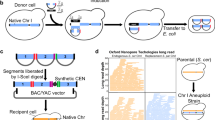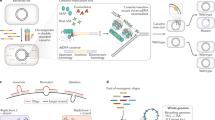Abstract
The development of mammalian artificial chromosomes (MACs) would be useful for biotechnology and biomediclne, including their use in functional genomics, transgenic animals and gene therapy. By analogy to large cloning systems in microorganisms, MACs may be engineered using endogenous chromosomal elements such as the yeast-based artificial chromosomes (YACs), or exogenous extra-chromosomal components derived from viruses and other cellular parasites such as the bacterial-based artificial chromosomes (BACs) and p1 artificial chromosomes (PACs).
This is a preview of subscription content, access via your institution
Access options
Subscribe to this journal
Receive 12 print issues and online access
$209.00 per year
only $17.42 per issue
Buy this article
- Purchase on Springer Link
- Instant access to full article PDF
Prices may be subject to local taxes which are calculated during checkout
Similar content being viewed by others
References
Fair, C.J., Bayne, R.A., Kipling, D., Mills, W., Critcher, F., and Cooke, H.J. 1995. Generation of a human X-derived minichromosome using telomere-associated chromosome fragmentation. EMBO 14: 5444–5454.
Heller, R., Brown, K.E., Burgtorf, C., and Brown, W.R. 1996. Mini-chromosomes derived from the human Y chromosome by telomere directed chromosome breakage. Proc. Natl. Acad. Sci. USA. 93: 7125–7130.
Sun, T.-Q., Fenstermacher, D., and Vos, J.-M.H. 1994.Human artificial episomal chromosomes for cloning large DNA in human cells. Nature Genet. 8: 33–41.
Simpson, K., McGuigan, A., and Huxley, C. 1996. Stable episomal maintenance of yeast artificial chromosomes in human cells. Mol. Cell. Biol. 16: 5117–5126.
Banerjee, S., Livanos, L., and Vos, J.-M.H. 1995. Therapeutic gene delivery in human B-lymphoblastoid cells by engineered non-transforming Epstein-Barr virus. Nature Medicine 1: 1303–1308.
Wang, F., Xiangping, L., Annis, B., and Faustman, D.L. 1995.Tap-1 and Tap-2 gene therapy selectively restores conformationally dependent HLA class I expression in type I diabetic cells. Hum. Gene Then 6: 1005–1017.
Sun, T.-Q., Livanos, E., and Vos, J.-M.H. 1996.Engineering a mini-herpesvirus as a general strategy to transduce up to 180 kb of functional self-replicating human mini-chromosomes. Gene Ther. 3: 1081–1088.
Featherstone, T. and Huxley, C. 1993. Extrachromosomal maintenance and amplification of yeast artificial chromosome DNA in mouse cells. Genomics 17: 267–278.
Nonet, G.H. and Wahl, G.M. 1993. Introduction of YACs containing a putative mammalian replication origin into mammalian cells can generate structures that replicate autonomously. Somatic Cell and Mol. Genet. 19: 171–192.
Harrington, J.J., Bokkelen, G.V., Mays, R.W., Gustashaw, K., and Willard, H.F. 1997. Formation for de novo centromeres and construction of first-generation human artificial microchromosomes. Nature Gen. 15: 345–355.
Kipling, D. and Warburton, P.E. 1997. Centromeres, CENP-B and Tigger too. Trends in Genet. 13: 141–145.
Brown, W. and Tyler-Smith, C. 1995. Centromere activation. Trends in Genet. 11: 337–339.
du Sart, D., Cancilla, M.R., Earle, E., Mao, J.-l., Safferey, R., Tainton, K.M., et al. 1997. A functional neo-centromere formed through activation of a latent human centromere and consisting of non-alpha-satellite DNA. Nature Gen. In press.
Kosztolanyi, G., Mehes, K., and Hook, E.B. 1991. Inherited ring chromosomes: an analysis of published cases. Hum. Gen. 87: 320–324.
DePamphilis, M.L. Origins of DNA replication, pp. 45–87 in DNA replication in eukaryotic cells. Cold Spring Harbor Laboratory Press, Cold Spring Harbor, NY (1996).
Tomizuka, Yoshida, H., Uejima, H., Hiroyuki, K., Sato, K., Ohguma, A., et al. 1997. Functional expression and germline transmission of a human chromosome fragment in chimaeric mice. Nature Genet. 16: 133–143.
Author information
Authors and Affiliations
Rights and permissions
About this article
Cite this article
Vos, JM. The simplicity of complex MACs. Nat Biotechnol 15, 1257–1259 (1997). https://doi.org/10.1038/nbt1197-1257
Received:
Accepted:
Issue Date:
DOI: https://doi.org/10.1038/nbt1197-1257
This article is cited by
-
Establishment of an oriP/EBNA1-based episomal vector transcribing human genomic β-globin in cultured murine fibroblasts
Gene Therapy (2002)
-
Epstein-Barr–based episomal chromosomes shuttle 100 kb of self-replicating circular human DNA in mouse cells
Nature Biotechnology (1998)
-
Human artificial chromosomes coming into focus
Nature Biotechnology (1998)



